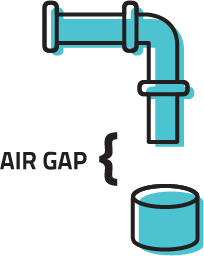Backflow prevention is the term used to refer to the prevention of an unwanted reverse flow of water from a potentially polluted source into the drinking water supply.
Backflow prevention for water trucks
Why is backflow prevention important?
A backflow device prevents water accidentally siphoning out of the tank back into the supply pipe if the pressure drops unexpectedly.
An Air Gap is the preferred method of backflow prevention device for water trucks.

Backflow prevention for commercial activities
Why is backflow prevention important?
Some commercial activities will require backflow prevention and containment devices to protect the water supply from potential contamination.
A correctly selected backflow prevention device (one way valve) will eliminate any risk of contamination of the drinking water supply.
How to apply for a backflow prevention device
Application and registration of a backflow prevention device is managed by your local council. For more information please contact:
Water truck FAQs
Backflow certificates are required for:
- all tanks accessing potable or recycled water
- any activity deemed high risk by Unitywater when hiring a standpipe.
A backflow prevention certificate (Form 9) must be issued by a licensed plumber (for backflow certification) of your choice and sent with your application to hire a standpipe or access potable water fill stations or recycled water fill stations.
Backflow certification is valid for 12 months from the date of issue and ongoing annual certification is required.
Commercial business FAQs
Backflow occurs because a condition exists in a water supply system that will cause back-siphonage or back-pressure. Back-siphonage can occur on a property through a vacuum created in the water supply system.
An example of back-siphonage would be a pipeline breakage, undersized pipework or high withdrawal rates. Back-pressure can occur within properties when high pressure is generated downstream by pumps, thermal expansion or elevation.
Backflow prevention starts within a property boundary by isolating a possible contamination source from the town mains or storage tanks (rainwater tanks) from the tap or appliance.
- fire hose reels (FHR)
- irrigation
- swimming pools
- vehicle-maintenance pits
- ornamental ponds
- air-conditioning towers
- vehicle/bin-washing bays
- chemical injection areas
- motels and unit complexes
- hotels
- vehicle-repair workshops
- shops
- restaurants
- caravan parks
- medical and dental surgeries
- car and plant-washing facilities
- dry-cleaners and laundries
- hospitals and funeral parlours
- club houses for sports
- schools
- day-care centres and kindergartens
- pest control and water-carrying vehicles
- botanical gardens.
A correctly selected backflow prevention device (one-way valve) will eliminate any risk of contamination of the drinking water supply. Backflow devices are either testable or non-testable types with the selection dependent on the risk associated with the possible contamination.
.jpg?as=1&h=180&iar=1&w=240&sc_lang=en&hash=ED2635AB56C05C447C81859A6494759D)

.jpg?as=1&h=180&iar=1&w=240&sc_lang=en&hash=825CA525B857A18B3E79ED458DEEE801)

